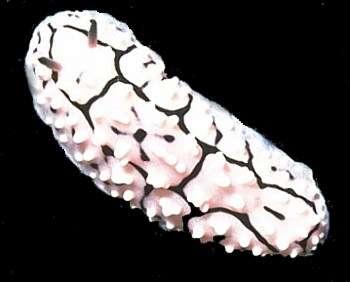
Phyllidiella lizae
Brunckhorst, 1993
Order: NUDIBRANCHIA
Suborder: DORIDINA
Superfamily: EUDORIDOIDEA
Family: Phyllidiidae
DISTRIBUTION
Known from the tropical western Pacific Ocean.
PHOTO
10 m depth, "Tenements 1", Heron Island Reef, GBR, 26 Nov. 1987, dorsal view of holotype (36 mm) (Brunckhorst, 1993: Plate 7B).
Notes compiled from Brunckhorst, 1993:
P. lizae is recognisable by its pale pink notum with simple, rounded, pale pink tubercles, narrow black lines crossing the dorsum, and black, white and pink rhinophores. Other distinguishing characters are the pale, pinkish white oral tentacles and foot sole.
It appears to have a greater number of lamellae (23-28) to the rhinophoral clavus than Phyllidiella pustulosa (22-26), although their ranges overlap. However, the two species differ considerably in the coloration of the rhinophores, and in their dorsal and ventral background coloration. Phyllidiella granulata has a granular pink-grey dorsum with tall compound white tubercles, fewer lamellae to the rhinophoral clavus, and bright orange digestive gland mass. Phyllidiella rudmani also has a pink background colour to the dorsum, has tall, steep tubercles (low in P. lizae) and two, straight, longitudinal black stripes (irregular, criss-crossing black lines in P. lizae).
Reference:
• Brunckhorst, D.J. (1993) The systematics and phylogeny of Phyllidiid Nudibranchs (Doridoidea). Records of the Australian Museum, Supplement 16: 1-107.
Rudman, W.B., 1999 (September 12) Phyllidiella lizae Brunckhorst, 1993. [In] Sea Slug Forum. Australian Museum, Sydney. Available from http://www.seaslugforum.net/find/phylliza
Related messages
Phyllidiella lizae from Sulawesi
June 6, 2007
From: Sebastian Ferse

Hi Bill,
I found this specimen in Tomini Bay, Central Sulawesi on a wall at around 20 m depth. I am not sure whether it is Phyllidiella annulata or P. pustulosa.
Could you help me with the I.D.?
Locality: Mini Canyon, Kadidiri, Togian Islands, 20 m, Central Sulawesi, Indonesia, Pacific Ocean, 10 March 2007, Wall with many hard and soft corals, sponges, and gorgonians. Length: 4 cm. Photographer: Sebastian Ferse.
Thanks
Sebastian
sebastian.ferse@zmt-bremen.de
Ferse, S.C.A., 2007 (Jun 6) Phyllidiella lizae from Sulawesi. [Message in] Sea Slug Forum. Australian Museum, Sydney. Available from http://www.seaslugforum.net/find/19730Dear Sebastian,
Phyllidiids are not that easy to identify and I suspect we still have some sorting out to do. This animal is a very good match for Phyllidiella lizae, both in rhinophore colour and the black diagonal cross on the back.
Best wishes,
Bill Rudman
Phyllidiella hageni ? from Fiji
May 21, 2007
From: Lindsay Warren

Dear Bill
Please find attached photos of this phyllidiid I found in Fiji in July 2006. My immediate reaction on seeing this specimen was that it was Phyllidiella hageni as the dorsal features (colour, tubercle arrangement, black lines) seem to fit the original description. However, this specimen lacks the thin mantle margin and the anal pocket is quite short although that could be because it is contracted.
In addition to this the oral tentacles are not tipped in black/grey (a noted feature in the original description by Fahrner & Beck); there is crosshatching on the translucent hyponotum through which one can clearly see the tubercles - neither of which were noted by Fahrner & Beck.
As a result I am confused and not at all sure what this specimen is. Perhaps you might be able to shed some much needed light. As you have said before, the phyllidiids are a very confusing group and just when it all seems clear, another one comes along to 'muddy' the waters but then it does keep the whole subject forever fascinating!
Locality: 'Zoo' divesite, Nanuya Island, 51 ft / 15.2 m, Yasawas, Fiji, Tropical Western Pacific, 24 July 2006, 10:28, Steep slope to sheer drop off, reef in excellent condition. Length: 35 mm. Photographer: Lindsay Warren.
All the best and many thanks
Lindsay
lwarren@datonomy.co.uk

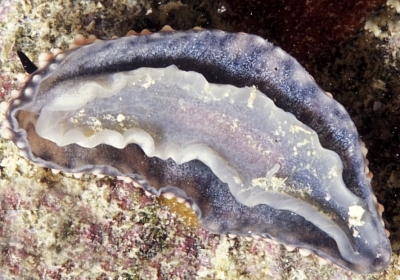
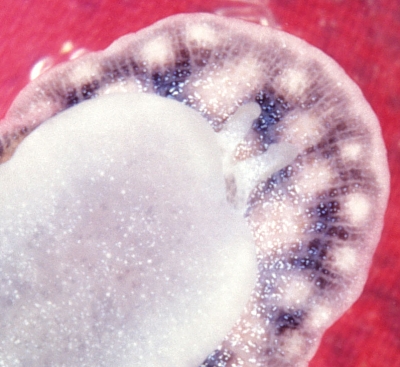
Dear Lindsay,
This is a bit of a puzzle. The tri-coloured rhinophores suggest this is a species of Phyllidiopsis, and it looks like Phyllidiopsis krempfi, but the oral tentacles in Phyllidopsis are completely fused, while in your animal they are completely separate. Separate rhinophores like this are found in Phyllidiella but the rhinophores in that genus are mostly black. However two species, P. rudmani and P. lizae have pink and black rhinophores. Phyllidiella lizae is described as having rhinophores "black apically, pink centrally and white basally" which fits you animal very well. The arrangment of pustules is a bit different but that might be variability.
If its not P. lizae, I have no idea, the separate oral tentacles don't leave us with many alternatives as I am sure it is not a species of Phyllidia, Fryeria or Reticulidia which also have separate oral tentacles. I am not sure if the patch of orange sponge is of significance but a number of species of Phyllidiella, including P. granulatus, P. rudmani and P. burni have been reported feeding on orange species of the sponge genus Phakellia.
Best wishes,
Bill Rudman
Phyllidiella lizae from the Coral Sea
October 3, 2005
From: Marc Saunders
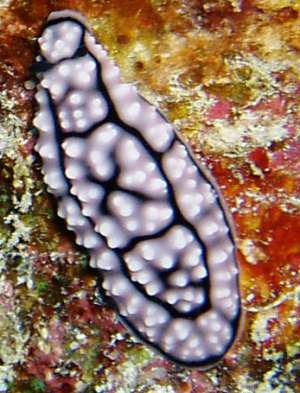
Dear Dr. Rudman,
Here is a second species from our dive on Big Dipper, an extended system of reef and bommies on the outer GBR straight out from Townsville.
Locality: Big Dipper, outer Great Barrier Reef , east of Townsville, Queensland, Australia. Coral Sea. Depth: 12 m. Length: 1.5 cm. 20 April 2005. Photographer: Marc Saunders.
Regards,
Marc Saunders
marc@irm.net.au
Saunders, M., 2005 (Oct 3) Phyllidiella lizae from the Coral Sea. [Message in] Sea Slug Forum. Australian Museum, Sydney. Available from http://www.seaslugforum.net/find/14865Dear Marc,
This is a species of Phyllidiella. Unfortunately there are a group of species which tend to merge from one to another. This could be a form of the very common Phyllidiella pustulosa or possibly Phyllidiella lizae. From the distinctive black X mark on the mantle, I think this is P. lizae, a view supported by the tubercles which are considered as 'single' rather than 'compound' in this species. One sure way to differentiate them is that in P. pustulosa the rhinophores are black, while in P. lizae, there are three bands - an apical black one, then a pink central band, and a white basal one, Unfortunately in your photo the rhinophores are partly contracted so this detail is not available. I suspect this is Phyllidiella lizae but I can't be 100% sure.
Best wishes,
Bill Rudman
Phyllidiella lizae from Indonesia
October 5, 2003
From: Yasman
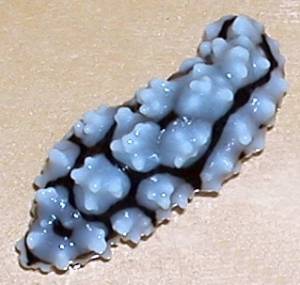
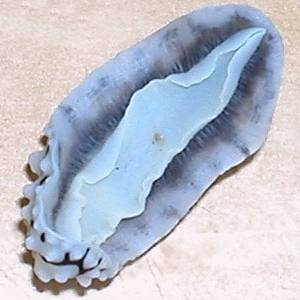
Dear Bill,
Up to now, I keep this species as a Phyllidiella granulata. The body and rhinophores's color are white. It was collected at Pramuka Island, Thousand Islands National Park, Indonesia (June, 15 2002). By just comparing the specimen to Brunckhorst's pictures, it only seems to fit P. granulata. I have only two specimens of the species.
Best regards,
Yasman
yasman.yasman@uni-duesseldorf
Dear Yasman,
I suspect this species is Phyllidiella lizae. The rhinophores in P. granulata are black so your description of them being white in these animals suggests P. lizae in which they are pink and white with a greyish black tip. Another cgaracteristic of P. lizae is the black rectangular spot in the centre of the dorsum with a diagonal line running out from each corner. Although not as obvious as the photo of the holotype, your photo certainly shows 4 greyish grooves in the right place.
I am afraid it is still early days in our understanding of the species in this family. We still need to do a lot more sampling and research into their biology before we can confidently identify the species. Brunckhorst's revision was a major advance in our understanding of the family, but as with all taxonomic revisions, I am sure there will be aspects of it that will need to be revised. We will only be able to do that when we accumulate a lot more information.
Best wishes
Bill Rudman
Phyllidiella lizae from Vanuatu
December 20, 1999
From: Vinka Stenhouse

Dear Bill,
This one was photographed at 6 meters at Espiritu Santo Is., Vanuatu, 1997. It was 32mm long. PHOTO: J.K. Stenhouse.
Yours sincerely,
Vinka Stenhouse.
Santo.
Vanuatu.
Dear Vinka,
I'm pretty sure this is Phyllidiella lizae. You can even see a trace of the diagonal cross pattern which is visible in Brunckhorst's published photo at the top of the page.
Best wishes.
Bill Rudman.
